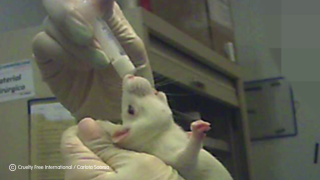
We call for urgent review of the ‘gavage’ procedure routinely used in experiments
We have published groundbreaking analysis which exposes the dangers of force-feeding animals during scientific tests.
Gavage – which involves forcibly inserting a tube, typically made of metal, down an animal’s throat to deliver substances directly into the stomach - is one of the most commonly used methods for administering chemicals or drugs to animals in regulatory toxicity tests.
Monkeys, dogs, rabbits and rodents are all subjected to this process which, although commonly used in toxicity testing to ensure precise dosing, is known to cause significant stress, injury, and even death.
It is the same force-feeding method used in the controversial production of foie gras, which has been banned in several countries, including the UK, Germany, Italy, Australia and India, on animal welfare grounds.
Our analysis found that in 21% of the toxicity test reports reviewed, deaths or other signs of injury were directly attributed to the gavage procedure itself. These are often caused by repeated dosing leading to injuries in the mouth, throat, or lungs, or by mistakes such as accidental puncturing of the oesophagus or inserting the tube into the lungs.
The analysis, published in ATLA (Alternatives to Laboratory Animals), reviewed the reports from 300 repeated-dose toxicity tests using rats, which had been submitted under the EU’s REACH chemicals regulation. The analysis also revealed that in 16% of the test reports reviewed, respiratory problems and other clinical signs consistent with "gavage-related reflux" were described – this is a painful and dangerous condition where the test substance enters the lungs, causing symptoms like breathing difficulties, excessive salivation, nasal discharge, and animals displaying signs of distress such as rooting in or eating its bedding. However, these symptoms were often not attributed to the gavage procedure in the toxicity test reports, leading to misclassification and underreporting of the suffering involved.
The analysis found that the risk of an individual animal dying due to a gavage incident is 1 in 250, while the risk of an entire study, involving multiple animals, being affected by at least one death is 1 in 7 – this qualifies as "very common" in the established side-effect reporting systems.
These findings raise serious concerns about the classification of gavage under EU Directive 2010/63. Currently, the procedure is described as causing only "mild" suffering, but the evidence now suggests that this classification does not accurately reflect the severe harm it can cause. Such misclassification could hinder the accurate reporting of suffering, essential for legal compliance under EU and UK laws, and obstruct efforts to uphold the 3Rs (Replacement, Reduction, and Refinement) principles.
Moreover, the stress caused by gavage has been shown to interfere with experimental results, introducing variables that may skew data and undermine the reliability of toxicity studies. This not only exacerbates animal suffering but also calls into question the validity of data produced by such experiments.
The public is often not fully informed about what commonplace animal experiments entail, and greater transparency is needed to drive meaningful change. An urgent review of the use of gavage in regulatory testing is essential, alongside better reporting of welfare incidents and accelerated investment in the development and adoption of humane, non-invasive alternatives.
Our Deputy Director of Science and Regulatory Affairs, and co-author of the study, Laura Rego Alvarez, said: "Our research shows that gavage is far from the safe and benign procedure it is often viewed as. It can cause immense suffering and even death, yet its use has been normalised and the impact is hidden from public view. We urgently need greater transparency to expose what is really happening to animals in laboratories. While we remain committed to ending all animal experiments, we believe that until that day comes, it is essential to reduce suffering wherever possible. Procedures like gavage must be classified as causing severe suffering – not minimised or overlooked – and work urgently needed to replace these cruel tests on animals must continue."
